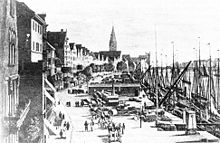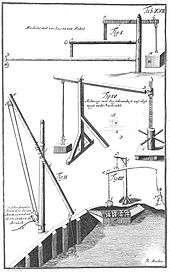Cranes at the Bremen Schlachte

The cranes on the Bremen Schlachte were hoists in various forms of construction (Wuppen, harbor cranes ), which were used to handle goods at the Schlachte quay , the port of the Hanseatic City of Bremen on the Weser in pre-industrial times.
Quay
The use of cranes in port operations always presupposes that there is a steep-walled quay system on the edge of which these hoists handle the handling of heavy goods between the shore and the moored ship . Since the second half of the 15th century at the latest, but probably much earlier, Bremen on the Weser with the inland port Schlachte had such a facility, which was initially made of sand and fixed with stakes, wattle and daubing, and then renewed in stone around 1580 . Changed and improved many times, the steep quay wall has been preserved until very recently. It was not until after the Second World War that it was given an unhistorical distance from the river due to a fill, but the wall is brought closer to the walker's eyes on the promenade that has been laid out and has been widened again since the end of the 20th / beginning of the 21st century into a promenade .
Wuppen
Forerunners of the cranes equipped with winches were lifting booms , which were called seesaws (northern German: Wuppen ). Each seesaw consisted of a 12- meter- long, double-armed lever, which could be tilted and rotated in the middle at the top of a high mast. Its first mention in 1489 suggests the existence of a quay that allowed larger seagoing vessels to approach immediately. Five to six such seesaws, later provided with pulleys and distinguishable by colored paint, were set up on the Schlachte and remained present until the late 18th century.
Cranes
In the second half of the 16th century, the quay was built into the deep waters of the Weser and fortified with a stone wall. In the first decades of the 17th century at the latest, the first pedal crane for heavy loads was erected on the edge of the harbor. It belonged to a type of construction in which the treadle construction together with the roof was rotatably mounted around a vertical axis in a fixed housing. The building can be seen sufficiently clearly on the Bremen cityscape by Merian (1638/41).
In 1684 it was replaced by another model, presumably the one that Jacob Leupold , an important technical master builder of the Baroque era, had seen in Bremen and, like the rocker in his standard work on hoists of the time, described and illustrated as exemplary. According to this, the Bremen crane was activated by two treadmills, in which up to six sick men wound the load rope onto a shaft while running and thus, depending on the direction of travel, raised or lowered the load. With this type of crane, only the boom could be swiveled (on the copper engraving it is shown shortened for reasons of space), to the tip of which the load rope was attached. From there it ran like a pulley system over a block that held the load hook, over various pulleys, back to the main shaft mentioned. Leupold estimated the lifting capacity of this crane to be over three tons .
Most of the envelope was moved by hand by the so-called maskop carriers in the form of sacks and small bins. Only heavier units such as heavier piece goods, e.g. B. stone blocks were lifted with the crane.
Following the example of the iron harbor cranes, which were first built in England a decade earlier, hand-operated iron crank cranes were also installed at Bremen's Schlachte from 1837, which completely replaced the old Wuppen and the pedal crane by 1856. The crank cranes were no longer replaced by steam cranes, as there were u. a. due to the lack of a railway connection (cf. Weserbahnhof , 1860), the Schlachte rapidly declined in importance as a transshipment port. As the only remnant of the former hoists still visible today on the quay wall at the level of the second battle gate of the Schlachte, only a semicircular base for one of the swiveling iron cranes has been preserved.
literature
- Dieter Bischop : Bremen Schlachte - hustle and bustle in the medieval port. In: Archeology in Germany (AiD), issue 3/2009, ISSN 0176-8522 .
- Ulrich Weidinger: With cogs to the market square. Bremen's port structures from the early Middle Ages to the beginning of industrialization. Hauschild Verlag, Bremen 1997, ISBN 3-931785-09-2 .
- Jacob Leupold : Theatrum Machinarum, or: Schau-Platz der Heb-Zeuge (= Theatrum Machinarum , Volume 4). Zunkel, Leipzig 1725, § 196, p. 105 ff., Panels XVIII and XXXII (reprint: Edition libri rari Schäfer, Hannover 1982, ISBN 3-88746-023-5 ).




